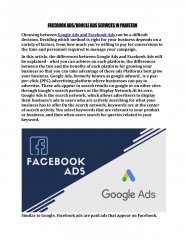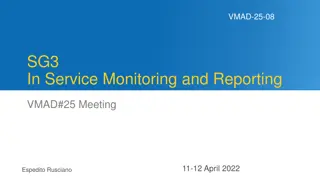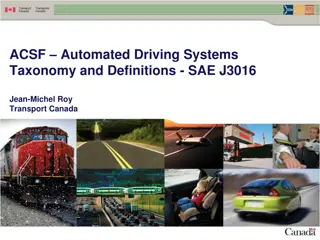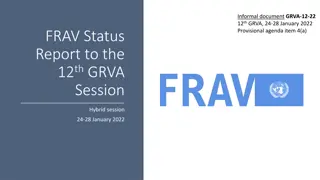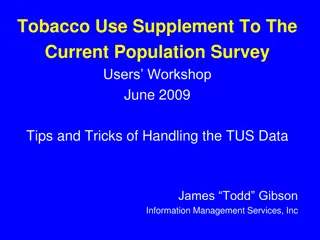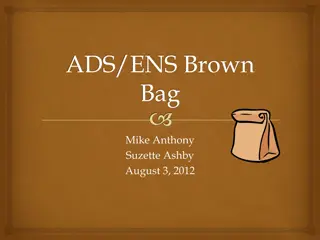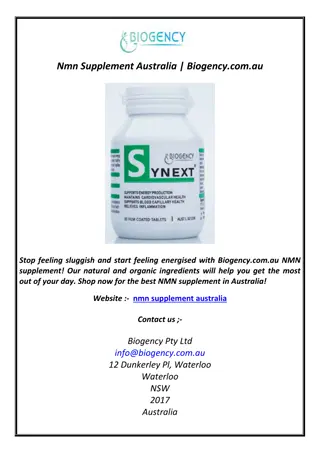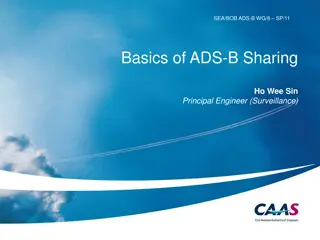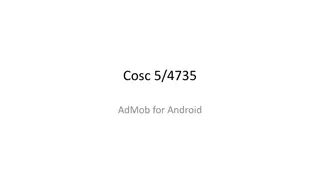Understanding Additional Dwelling Supplement (ADS) in Scotland
The Additional Dwelling Supplement (ADS) in Scotland applies to purchases of buy-to-let properties and second homes, with the aim of supporting first-time buyers in the housing market. This supplement is calculated as 3% of the total chargeable consideration for an additional residential property valued at £40,000 or more. ADS is payable in addition to the Land and Buildings Transaction Tax (LBTT). Transactions where the buyer owns more than one dwelling and has not replaced their previous main residence may fall under ADS. Legislative processes, key issues, and next steps are outlined in this informative content.
Uploaded on Sep 26, 2024 | 0 Views
Download Presentation

Please find below an Image/Link to download the presentation.
The content on the website is provided AS IS for your information and personal use only. It may not be sold, licensed, or shared on other websites without obtaining consent from the author. Download presentation by click this link. If you encounter any issues during the download, it is possible that the publisher has removed the file from their server.
E N D
Presentation Transcript
Revenue Scotland LBTT Webinar Thursday 24 March 11:30
Additional Dwelling Supplement (ADS) Structure 1. Background / context 2. Legislative process 3. How ADS works 4. Transitional arrangements 5. Key issues 6. Next steps 24/3/2016
1. Background / context Proposed by Deputy First Minister in Scottish Government s Draft Budget 2016/17 in December 2015 ADS applies to purchases of buy-to-let properties and second homes Policy objective is to ensure that the opportunities for first time buyers in the Scottish housing market remain strong Follows Chancellor s 2015 Autumn Statement announcement 24/3/2016
2. Legislative process Land and Buildings Transaction Tax (Amendment) (Scotland) Bill available on Scottish Parliament website, see Finance Committee Introduced to Parliament on 27 January 2016 Stage 3 debate: 8 March 2016 Royal Assent anticipated by 31 March 2016 ADS expected to apply from 1 April 2016 24/3/2016
3. Calculating the amount of ADS ADS is 3% of total chargeable consideration for an additional residential property of 40,000 or more E.g. For 200,000 second home, ADS= 6,000 ADS is payable in addition to the LBTT that would be due on the acquisition Any house already owned must also be worth 40,000 or more for the ADS to apply Paid by making an LBTT return and payment to Revenue Scotland using the SETS online return system. No separate return or payment is required Dwellings outside Scotland worth 40,000 or more are counted for ADS purposes 24/3/2016
Transactions to which ADS applies The ADS applies where the buyer buys a home worth more than 40,000 and at the effective date, owns more than 1 dwelling and has not replaced their previous main residence. The previous main residence is replaced if it was sold up to 18 months prior to the effective date. Buyer must intend to occupy the acquired property as their next main residence. 24/3/2016
Example 1: Individual purchase Standard buying new home, selling existing home scenario Johnny and Steven are selling the dwelling which is their main residence and they are purchasing a dwelling to be used as their next main residence. At the end of the effective date of the transaction, Johnny and Steven own one dwelling, so they will not pay the ADS. 24/03/2016
Example 2: Individual purchase Standard buy-to-let transaction Roni already owns a dwelling which is her main residence and is purchasing a dwelling that will be used as a buy-to-let. At the end of the effective date of the transaction, Roni owns two dwellings and has not replaced her main residence, so the ADS will apply. 24/03/2016
Example 3: Individual purchase Buyer owns rental properties, main residence being replaced Lou and Nico are buy-to-let investors with 10 dwellings in their portfolio. They also own another dwelling which they use as their main residence. They decide to sell their previous main residence and purchase their next main residence. At the end of the day that is the effective date of the transaction, Lou and Nico own 11 dwellings their next main residence and their 10 buy-to-let dwellings. However, as they have replaced their previous main residence they will not pay the ADS. 24/03/2016
4. Transitional arrangements If the buyer entered into the contract before 28 January 2016 (the date the Bill was introduced) the ADS will not apply, whatever the effective date is. If the buyer entered into the contract on or after 28 January, 2016, and the effective date of the transaction is on or after 1 April 2016, the Additional Dwelling Supplement will apply. 24/3/2016
5. Key issues i. Buyer replacing their main residence In most cases, sale of previous main residence will take place on or before the effective date of the purchase of the next main residence In some cases, the sale may occur after the effective date, so 2 homes are owned on that day If sale of previous main residence takes place before the tax return for the purchase of next main residence is made, no ADS is due Otherwise, ADS is due. But if sale of previous main residence takes place within 18 months of effective date, claim for repayment of ADS can be made 24/3/2016
Key issues ii. Claiming a repayment of ADS Same process as the claim for any repayment of tax A repayment can be claimed by either amending the LBTT return if within the 12 month amendment period If the amendment period has expired, a claim for repayment of an overpayment of tax to Revenue Scotland must be made in writing 24/3/2016
Key issues iii. Individuals / companies acquiring a residential property If an individual buys a residential property and retains a home they already own, the ADS applies. If an individual lives in a rented home and buys a residential property, the ADS does not apply. If an individual buys a residential property in a capacity as a company owner, the ADS applies. The ADS applies to any acquisition of a resdiential property by a company, even the first property. 24/3/2016
Example 4: Sole trader property investment business purchase Brian runs a sole trader property investment business, Placebo Properties, that currently owns only non-residential property. Brian decides to buy a residential property through the business to rent out. Brian lives in rented accommodation and so the dwelling bought by his business will be the first dwelling that he owns. However, as the dwelling has been acquired in the course of a property investment business, the ADS will be payable. 24/03/2016
Key issues iv. Acquisition of residential and non-resi property E.g. shop, with flat above The ADS applies to the chargeable consideration attributable to the acquisition of a dwelling, on a just and reasonable apportionment 24/3/2016
Key issues v. Rules for certain buyers and transactions Joint buyers Spouses, civil partners, cohabitants, children Trustees and beneficiaries Long leases Proper liferents Joint owners / owners of shares 24/3/2016
Example 5: Joint buyers Susie lives at home with her parents and Steve owns a flat which he lives in and is not replacing. They decide to purchase a buy-to-let property together. At the end of the day that is the effective date of the transaction, as Steve owns two properties and has not replaced his main residence, the ADS will apply. It does not matter that this is the only property that Susie owns. 24/03/2016
Example 6: Spouse/civil partner/cohabitant/child under 16 Mr and Mrs Wainwright are married. Mr Wainwright owns a property (which he purchased on his own before he was married) where the couple live as their main residence. Mrs Wainwright then buys a property to be rented out. At the end of the effective date of the transaction, Mrs Wainwright "owns" two properties (she is the owner of the newly purchased property and, for the purposes of the ADS, is deemed to be the 100% owner of her spouse's existing property ("deemed ownership")) and is not replacing her main residence, so the ADS will apply. 24/03/2016
Example 7: Buying property for children to live in Mr and Mrs Moore own a main residence together. They decide to purchase a flat for their son to live in whilst he is at university. As they will own two properties and are not replacing their main residence, the ADS will apply to their flat purchase. It does not matter that the flat is not being rented out and is kept for family use only. If, however, Mr and Mrs Moore were to give their son money to purchase the flat and he was to take title in his own name then, provided their son did not already own another property, then the ADS would not apply. If their son took title to the property and was under 16, however, both Mr and Mrs Moore and their son would be treated as one economic unit for the purposes of the ADS meaning that the ADS would apply to the purchase as Mr and Mrs Moore already own another property. 24/03/2016
Key issues vi. Exemptions and reliefs Where existing LBTT exemptions and 100% reliefs apply to the transaction, they apply to the ADS too. Specific relief from ADS is available for purchases of 6 or more dwellings in a single transaction, within Scotland. 24/3/2016
Example 8: Inherited property Craig owns a property which he uses as a main residence. He inherits another property from his parents. An inheritance is not chargeable to either LBTT or the ADS, so Craig will not pay either, even though after the inheritance he owns two properties (his main residence and the inherited property, in respect of which he is deemed to be the 100% owner ("deemed ownership"). Craig decides to sell the inherited property and purchase a buy- to-let property with the proceeds. At the end of effective date of the transaction, Craig owns two properties and has not replaced his main residence. Therefore, he will pay the ADS on the newly purchased buy-to-let property. 24/03/2016
6. Further Information Website www.revenue.scot for FAQs and guidance SETS system withdrawn midnight 9am on 1 April 24/3/2016
Contact us Support Desk - 03000 200 310 LBTT mailbox LBTT@revenue.scot Revenue Scotland mailbox info@revenue.scot Secure Messaging Service within SETS for use by taxpayers and agents registered on our portal with specific questions or complex tax enquiries @RevenueScotland 24/3/2016



